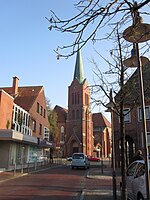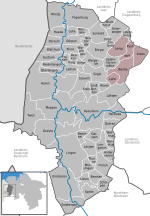Saterland
Cloppenburg (district)Municipalities in Lower SaxonyPages with German IPAPages with Saterland Frisian IPA

Saterland (German pronunciation: [ˈzaːtɐˌlant]; Saterland Frisian: Seelterlound, pronounced [ˈseːltɐˌloːunt]) is a municipality in the district of Cloppenburg, in Lower Saxony, Germany. It is situated between the cities of Leer, Cloppenburg, and Oldenburg. It is home to Saterland Frisians, who speak Frisian in addition to German. The municipality of Saterland was formed in 1974, when the smaller municipalities Strücklingen (Strukelje in Saterland Frisian), Ramsloh (Roomelse), Sedelsberg (Seeidelsbierich) and Scharrel (Schäddel) were merged.
Excerpt from the Wikipedia article Saterland (License: CC BY-SA 3.0, Authors, Images).Saterland
Imkerweg,
Geographical coordinates (GPS) Address Nearby Places Show on map
Geographical coordinates (GPS)
| Latitude | Longitude |
|---|---|
| N 53.033333333333 ° | E 7.7166666666667 ° |
Address
Imkerweg
Imkerweg
26683 (Sedelsberg - Seedelsbierich)
Lower Saxony, Germany
Open on Google Maps










